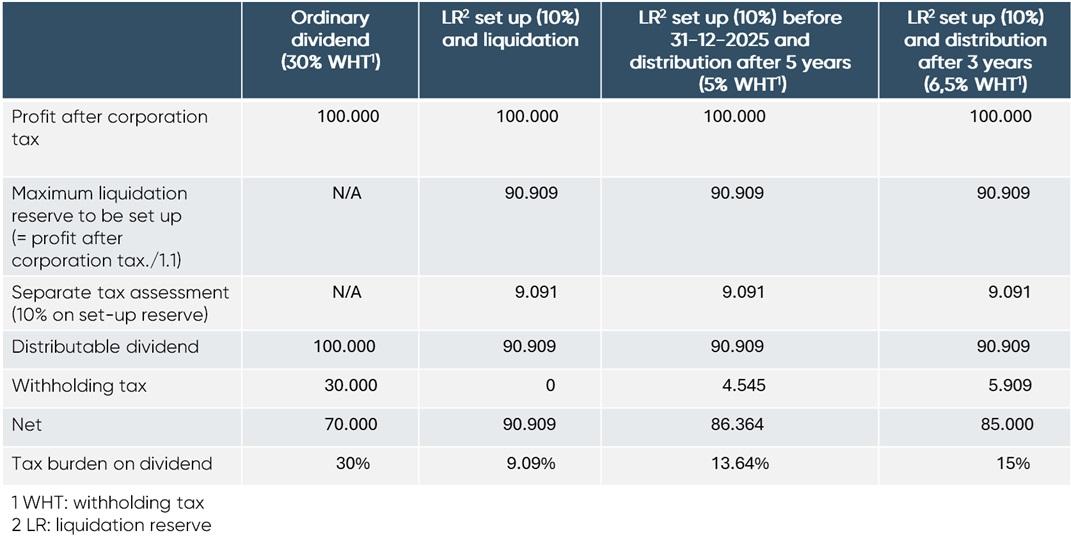
‘Arizona’ Government Agreement: practical details of tax plans for investors
Update 07-23-2025
In this post, we take a closer look at the further details of the tax plans and how they will affect investors, both private individuals and entrepreneurs.
More information on capital gains tax for private investors.
More information on the anti-abuse provisions for the annual tax on custody accounts.
More information on capital gains tax for entrepreneurs.
If a company pays dividends to shareholders who are natural persons, in principle 30% withholding tax is applicable. Using the VVPRbis tax reduction scheme (see below) and liquidation reserves, this tax burden can be reduced under certain conditions.
If a liquidation reserve is created, an additional 10% corporation tax is payable on the amount of the reserve. After a waiting period of five years, dividends can be distributed at a withholding tax rate of 5%. The total tax burden on distribution then amounts to 13.64% (see example).
For a distribution from liquidation reserves created on or after 1 January 2026, the waiting period will be reduced to three years. The withholding tax on distributions from the reserve after this waiting period is increased to 6.5%. As with the VVPRbis scheme, this brings the total effective tax burden on distribution to 15%.
Shareholders will thus have to wait less time for their distribution from the liquidation reserves, but the overall tax burden will be higher. The VVPRbis and liquidation reserve regimes are thus being harmonised as far as possible.
For liquidation reserves that were created before 1 January 2026 and that will be distributed from 29 July 2025, a choice can be made for a three-year waiting period (instead of five years). In that case, however, 6.5% withholding tax will have to be paid upon distribution (instead of 5% in the case of a five-year waiting period). If the Annual General Meeting held in May 2026 in respect of the financial year ending 31 December 2025 were to resolve to create a liquidation reserve, it will be able to choose between setting a three-year or five-year waiting period for distributions from the reserve. This is because the liquidation reserve was created before 1 January 2026.
For liquidation reserves created in the past, the following actions are possible in the financial year ending 31 December 2025:
- The liquidation reserve for financial year 2019 and previous financial years can be distributed at a withholding tax rate of 5% (five-year waiting period has been met);
- The liquidation reserve for financial year 2020 can be distributed at a withholding tax rate of 6.5% from 29 July 2025 (more than three-years waiting period has been met);
- The liquidation reserve for financial year 2021 can be distributed at a withholding tax rate of 6.5% from 29 July 2025 (more than three-years waiting period has been met).
Liquidation reserves created in three different financial years can thus be distributed in 2025 at the more favourable withholding tax rate of 5% or 6.5%.
Entrepreneurs will have to carefully weigh up what is most advantageous in their specific situation with regard to liquidation reserves that have already been created: immediate distribution at a withholding tax rate of 6.5% (if there are liquidation reserves that were created three or four years ago) or waiting until the five-year period has expired and then distribution at a withholding tax rate of 5%. Many factors come into play here: how quickly and for what purpose the entrepreneur needs the money for their personal use; what alternative funding options are available from their private assets, etc.. Note that a FIFO (first in, first out) principle applies when distributing liquidation reserves. If you decide to distribute liquidation reserves sooner than planned, you will pay 6.5% on the oldest reserves. You may be able to distribute those within a few months at a withholding tax of (only) 5%.
Please note that:
- For liquidation reserves created in or after January 2026, distributions within the three-year waiting period will always be taxed at the standard withholding tax rate of 30%, on top of the 10% tax already paid. Currently, a rate of 20% is applicable on distributions made within the waiting period. This remains the case for the early distribution of 'old’ liquidation reserves. This means that three possible rates apply to distributions from these reserves: 5% after five years, 6.5% after three years or 20% for distributions made less than three years after creation of the reserve.
- In the event of liquidation of the company, liquidation reserves can still be distributed tax-free. This means there is still the option to liquidate the company through the liquidation reserves with a total tax burden of 9.09% (see example).

Under the VVPRbis scheme, dividends can be distributed from the third financial year following the financial year of the company’s incorporation (or capital increase), with withholding tax being applied at a rate of 15%.
The Programme Act abolishes the 20% rate for contributions made after 31 December 2025, leaving only the standard rate of 30% and the favourable rate of 15%:
- 30% on distribution of profits for the financial year of incorporation (or capital increase) and for the following two financial years;
- 15% on distribution of profits for the third financial year after the year of incorporation (or capital increase) and for all subsequent financial years.
When a Belgian company receives dividends from another company, that dividend can be exempted from Belgian corporation tax by applying the 'dividends received deduction' (DRD). To be eligible for this deduction, three conditions must all be met at the time the dividend is declared:
- The taxation condition means that dividends received must relate to 'good' shares; these are shares in companies that are taxed 'normally' (and thus ‘finally') on their profits in the country where they are domiciled. If the company distributing the dividend pays little or no tax on its profits in the country in which it is established (for example in a tax haven), the dividend received cannot be exempted.
- The holding period condition means that dividends received must relate to shares held in full ownership for a continuous period of at least one year.
- The holding size condition means that the company receiving the dividends must hold shares equivalent to at least 10% of the capital of the distributing company or with an acquisition value of at least 2 500 000 euros.
The Programme Act will change (i.e. tighten up) the holding size condition: if the company receiving the dividends holds less than 10% of the capital of the distributing company, the minimum acquisition value of 2 500 000 euros will be maintained. In other words, the increase to 4 000 000 euros as set out in the Coalition Agreement has not been retained. If the recipient of the dividends is a large company, from assessment year 2026 a participating interest (holding) of less than 10% will moreover have to take the form of a 'financial fixed asset' to be eligible for the dividends received deduction.
For the term 'financial fixed asset', reference is made to the meaning assigned to it in accounting legislation. This implies that the shares held should be included under 'participating interests in affiliated entities', 'participating interests in companies linked by participating interests' or 'participating interests in other financial fixed assets'. Entering the shareholding under these items implies that the company wishes to have a lasting and specific connection with the company in which it invests and therefore does not see the participating interest purely as an investment.
Since the conditions applying for the dividends received deduction and the exemption from capital gains on shares in corporation tax are similar, there is an additional consequence for large companies. Capital gains on shares can only be exempted (for shareholdings of less than 10% and subject to some specific exceptions) if the acquisition value of the shares is at least 2.5 million euros and they are recorded as financial fixed assets.
This stricter holding size condition will apply immediately from assessment year 2026! Changes made between 3 February 2025 and the closing date of the financial year will not be accepted unless it can be demonstrated that the change was motivated by economic (i.e. non-tax-related) considerations.
For small companies, the conditions applying for the dividends received deduction and capital gains exemption on shares will not change. A company is deemed to be small if at the balance sheet date it does not exceed more than one of the following criteria:
- Annual average number of employees: 50
- Annual turnover, excluding value-added tax: 11 250 000 euros
- Balance sheet total: 6 000 000 euros
Exceeding more than one of these criteria will only have consequences if it occurs during two consecutive financial years. Please note that when assessing the criteria, not only the data of the company itself but also of 'affiliated companies' must be taken into account.
The announced changes regarding DRD Beveks are included in the draft law and are not yet finalised. We will report on this as soon as we have more news.
More information on the anti-abuse provisions for the annual tax on custody accounts.
This newsflash may not be construed as an investment recommendation or advice.
